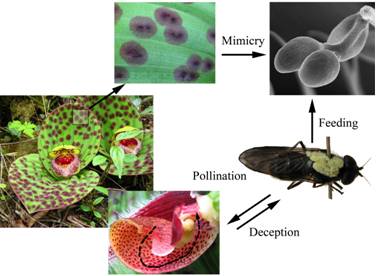Two years after his landmark work, “On the Origin of Species by Means of Natural Selection”, Charles Darwin in a letter to Joseph Hooker, the assistant director of the Royal Botanic Gardens Kew, wrote “I never was more interested in any subject in my life, than this of orchids”. In 1862, Darwin published a book “On the Various Contrivances by Which Orchids Are Fertilised by Insects” in which he described and identified most of the functional floral morphology and biomechanics in orchid pollination. However, Darwin never recognized that many of the flowers that he examined lacked edible rewards of food, e.g. nectar and granular pollen, and sex. In fact, floral evolution in the Orchidaceae appears to be dominated by modes of pollination-by-deceit, in which visual and/or olfactory cues mimic food sources, bodies of receptive females and oviposition sites. Prof. LI Dezhu’s group at the Kunming Institute of Botany (KIB), Chinese Academy of Sciences reported an unusual form of deceptive pollination mechanism in a single-flowered species of slipper orchid, Cypripedium fargesii, published online on April 18, 2011 in the Proceedings of the National Academy of Sciences, USA, entitled “Flowers of Cypripedium fargesii (Orchidaceae) fool flat-footed flies (Platypezidae) by faking fungus-infected foliage”(http://www.pnas.org/content/early/2011/04/12/1103384108.abstract).
Cypripedium fargesii is a nectarless, terrestrial, endangered orchid from southwestern China that requires cross-pollination to produce the maximum number of viable embryos. In this species, each short flowering stem bears two leaves with rows of black spots on the upper surfaces. The stem terminates in a small, solitary, dark-red to dull-yellow flower that produces a faint but unpleasant odor reminiscent of rotting leaves. Ph. D candidate REN Zongxin in KIB, supervised by Profs. LI Dezhu and WANG Hong and cooperating with Prof. Peter Bernhardt from Department of Biology, Saint Louis University, USA, conducted four years of pollination ecology studies on C. fargesii to elucidate its mechanism of floral mimesis and to interpret the function of the black spots on its leaves.
This research presented both the first example of floral mimesis of fungus-infected foliage in orchids and the first example of flat-footed flies as pollen vectors for angiosperms. All insects caught entering or leaving the labellum sac were flat-footed fly (Agathomyia sp., Platypezidae) carrying spores of black mold (i.e., conidia of Cladosporium sp.) on their mouthparts and legs, suggesting mycophagy. Blackish hairy spots on the upper surface of foliage may imitate black mold spots, serving as short-term visual lures. Some odor molecules also associated with Cladosporium cultures were isolated in the floral scent. The authors proposed that flowers of C. fargesii mimic fungus-infected plant organs to attract flat-footed fly to find fungal spores for food, which also based in part on modified scent components.
The authors suggested that mimesis of fungus-infected foliage probably represents an overlooked but important option in angiosperm diversification, since there are three to five more Cypripedium spp. in southwestern China with the same mode of floral presentation and black-spotted hairy leaves. This new mode of pollination-by-deceit may ultimately represent a "bridge" between generalist food mimesis and mimicry of mushrooms.
The authors dedicated this paper to the memory of the late Dr. Tom Eisner (1921-2011), father of chemical ecology and professor of entomology at the Cornell University.





